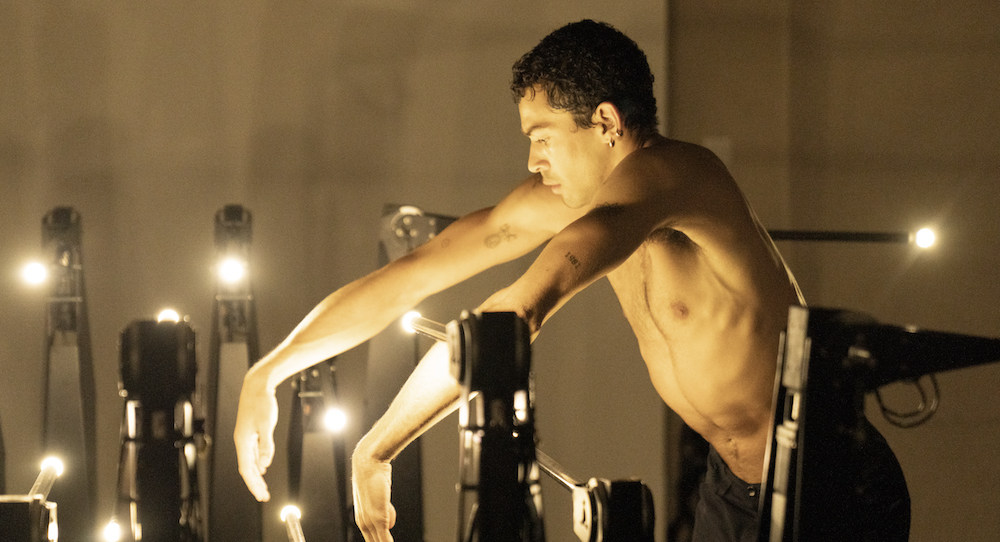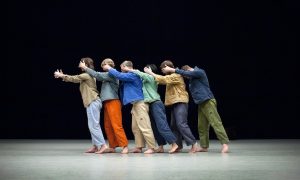Somerset House, London.
29 October 2025.
If you are a creative, I am sure you have felt an ominous presence when it comes to technology and AI. ‘How will it impact the industry?’ ‘Will I be replaceable?’
With the world’s first AI actor, Tilly Norwood, making headlines recently, and whispers of actors, voiceover artists, and those in editing and design being replaced by AI and software, I was curious to see how Olivier Award-winning choreographer Sir Wayne McGregor’s exhibition would integrate technology and movement.
It is safe to say that any dread I had about tech in the art and culture space has been replaced with intrigue — and, dear, I say, excitement.
Attending the press launch of Wayne McGregor: Infinite Bodies at Somerset House, London, on October 29, I was surrounded by dancers, creatives and cultural journalists and writers, all of whom were captivated by the exhibition as we walked around and digested what was a snapshot into the world of technology and dance at present and its potential future.
The exhibition is not only a reflection of some of McGregor’s previous work but also an insight into how technology can be merged with art and culture to bring in a new era.
The event kicked off with a series of welcome talks and the overarching idea that artists will sculpt the future. A short speech and Q&A by Infinite Bodies curator Dr Cliff Lauson, Director of Exhibitions at Somerset House, and McGregor himself followed, offering a clear picture of his creative processes; this element was so impactful and insightful that I wish all spectators and exhibit-goers had access to it, and that it was not just exclusive to the press launch.
Writer Philippa Dunn also curated Infinite Bodies.
For McGregor, collaboration and exploration are key to dance as well as developing and understanding physical intelligence and what that tells us about our view of the world. Our relationship to people, objects, and technology; how we interact with them; how we move away from certain people, expand and retract to environments and situations to either protect or display.
One clear thing was that McGregor had no concerns about technology replacing live theatre. He said that a collective audience sat together watching a show and sharing that inhale and exhalation of breath at moments were unmatched and that the human body is our greatest piece of technology.
“What if?” “Can I?” and “Shall we try?”, questions that drive his work were clear as you edged through the exhibition, intimate spaces filled with human movement, robotic actions, projections and soundscapes. The team behind this have put user journey and experience at the heart; after all, what is art and creativity without heart?
Housed in the cultural hub that is Somerset House, the display is an immersive walk-through spanning multiple levels, featuring live performances, technology showcases and archival epicentres of McGregor’s works.
A particular section that stopped me in my journey was Future Self, a throwback to McGregor’s 2012 work. A collaboration with Random International and McGregor set to a score by Max Richter. Two dancers performed around a brass grid comprising over 10,000 LED lights. In a conversation told through dance, the lights reflected their movement, creating an illuminated echo.
OMNI, 2025, a collaboration with Industrial Light & Magic, also provided for a stimulating watch. Perfectly blending dance and cinematic visuals, giving a depth and beauty to movement told through bodies formed of lights and synapses in almost a video game visual.
AI-powered choreography tool AISOMA allowed exhibition-goers the chance to perform and turn a short movement sequence into an AI project. Although a nice element, the outcome is somewhat raw compared to the rest of the exhibition, but it shows how easy it is to integrate tech into movement practice.
The exhibition also presented a preview of The Other Earth, a 360° cinematic choreographic installation. The full installation is located at Stone Nest in the West End. What we saw was only a fraction of the experience, which was impressive, but the full experience will see spectators surrounded by a 360-degree panoramic screen in a 3D experience that lasts 57 minutes.
A Body for AI links dance performance with a kinetic sculpture designed by Ben Cullen Williams, which moves as film and photographic material are performed on the metallic canvas.
Other works and installations include Random Internationals 2008 Audience, commissioned by McGregor while in his role as curator of the inaugural Deloitte Ignite Festival at The Royal Opera House in 2008. Putting audience members at the centre as 64 mounted mirrors motion tracking your movements, and the 2021 robotic sculpture No One is an Island.
Infinite Bodies runs until February 22 2026, and is a must for dance lovers and those wanting to see the future —or one possible future — of technology and art.
McGregor’s work is definitely at the intersection of technology and dance, and although creatives still need to be vigilant about technological developments, if they are at the forefront of integrating it into art, the possibilities are endless.
By Jamie Body of Dance Informa.














